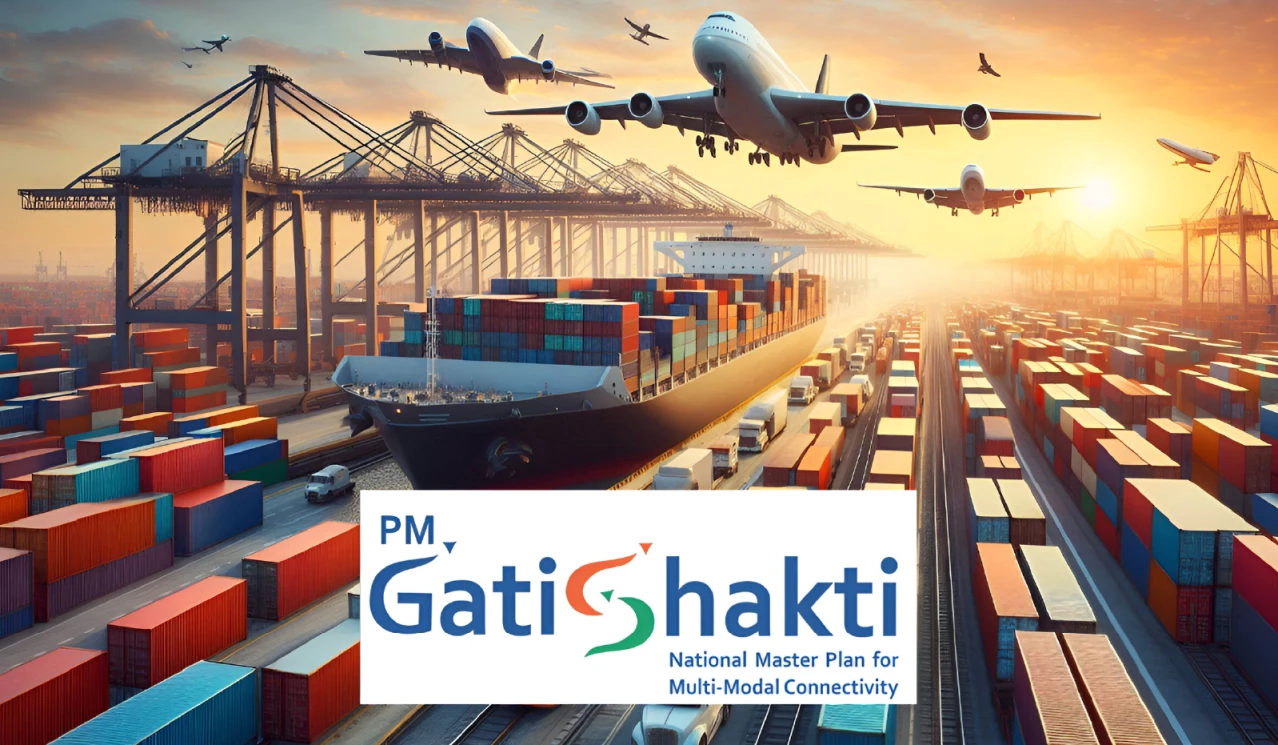Why in the News?
Recently, the PM GatiShakti National Master Plan, launched in 2021, has completed three years.
About PM GatiShakti (PMGS)
- PM GatiShakti: It is an approach for growth accelerating trustworthy infrastructure through synchronized, holistic, integrated, and comprehensive planning based on knowledge, technology and innovation.
- The approach is driven by 7 engines - Railways, Roads, Ports, Waterways, Airports, Mass Transport, and Logistics Infrastructure.
- Objectives: To enhance ease of living, ease of doing business, minimize disruptions and expedite completion of works with cost efficiencies.
- PM GatiShakti National Master Plan (PMGS NMP)
- It has been developed by the Digital Master Planning tool developed by BISAG-N (Bhaskaracharya National Institute for Space Applications and Geoinformatics) using GIS platform.
- It's built on open-source tech, hosted on Meghraj (Government of India's cloud) & Integrates ISRO satellite imagery and Survey of India basemaps.
- It provides comprehensive database of the ongoing & future projects of various Ministries. E.g., Bharatmala, Sagarmala, inland waterways, dry/land ports, and UDAN.

Why there was a need of PM GatiShakti National Master Plan?
- Disjointed Planning
- Lack of coordination leads to repeated road excavation for laying cables, gas pipes, and water lines by different departments independently, causing continuous public disruption and wasteful expenditure.
- Non-/ under-utilization of installed infrastructure
- Capacity inefficient planning results in completed infrastructure projects operating below optimal capacity, leading to significant revenue losses.
- E.g., LNG terminal in Kochi operated below capacity since 2013, due to delayed pipeline connectivity.
- Lack of Standardization
- Each component of infrastructure is designed as a unique project despite similar specifications which leads to wasteful expenditure across departments.
- E.g., EveryRailway Over Bridge (ROB) requires fresh Ministry of Road Transport & Highways design and Ministry of Railways approval, stretching timelines and causing public inconvenience.
- Lack of coordination and delays in clearances/approvals:
- Delays in obtaining even a single approval (clearances, land acquisition, etc) can cascade into significant project setbacks.
- E.g., A portion of Delhi-Meerut Expressway faced 11-month delay due to pending railway approval for one ROB, despite complete road construction.
How PM GatiShakti is removing barriers for infrastructure growth?
- Geospatial intelligence for smarter planning & monitoring: Utilising real-time data from GIS and satellite imagery, PMGS provides data-driven insights for more informed decision-making.
- Smart logistics for enhanced efficiency: The Unified Logistics Interface Platform (ULIP) is designed to improve efficiency, transparency, and coordination within the logistics sector.
- Breaking silos for a collective vision: The Network Planning Group (NPG) is synchronising efforts across ministries to ensure cohesive infrastructure development.
- Revolutionising project planning: With digital surveys, project preparation is now faster and more accurate. E.g., In a year, the Ministry of Railways has planned over 400 railway projects covering 27,000 km of railway lines.
- Multimodal Connectivity: By integrating highways, railways, ports, airports, mass urban transportation, and inland waterways, this initiative ensures the seamless movement of goods.
- Streamlines clearance procedures across agencies: E.g., Environment Ministry's online environmental clearance system has reduced approval timelines from 600 days to just 162 days.
What are the challenges faced by PM GatiShakti National Master Plan?
- Issue of interoperability and non-digitization of government data: Lack of standardization and universal protocols in government data storage and processing hinders data integration and development of integrated solutions.
- Inadequate digitization of Government data such as land records adversely impacts integrated decision-making.
- Data security concerns: Ministry of Electronics and IT have expressed reservations about sharing valuable infrastructure data.
- Risk of private companies potentially monetizing sensitive infrastructure data from the platform.
- Limited data sharing with private sector: It hampers optimal decision-making for projects under Rs 6 trillion national monetisation pipeline (NMP) involving core infrastructure assets.
- Major issue falling beyond the ambit of PMGS: Land acquisition is frequently the major roadblock to India's development. Due to issues regarding land acquisition, many development projects are postponed.
- Other Challenges not addressed by PMGS: E.g., legal problems, alienation of local populations due to infrastructural development, and environmental standards not complied with, etc.
How can India improve the implementation of PM Gati Shakti?
- Simplify bureaucratic procedures related to land acquisition and project approvals. Enhancing inter-departmental coordination can expedite these processes, which is crucial for timely project completion.
- Address certain key issues: Address structural and macroeconomic stability issues that result from large public spending.
- Tackle land acquisition decisions: Instead of acquiring new lands, policymakers should focus on using GIS and remote sensing to identify and redevelop already degraded or polluted areas for infrastructure projects.
- Open up Gati Shakti platform to the private sector: By granting private companies access to non-sensitive, shareable data, the government can foster an environment of collaboration and transparency.
- District-level expansion: PM Gati Shakti District Master Plan portal would ensure decentralized planning, promoting inclusive growth across regions and local communities.
Conclusion
The PM Gati Shakti initiative represents a transformative approach to infrastructure development in India, aiming to create a seamless and efficient multimodal transportation network. By integrating the efforts of various ministries and leveraging advanced technologies, this initiative seeks to enhance connectivity and reduce logistics costs across the nation.





